场景举例:分类信息展示
实际开发里,可能有的数据是由多个接口调用获取,那多个接口需要伪嵌套
(1)需求:表单中用户姓名与职业的分类信息展示
1、初步模板如下


2、需求:做一个用户编辑操作,但这里注意职业是从服务端动态差进来的

所以这里需要两张表,即用户表+职业表
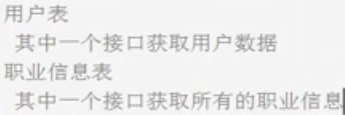
注意:用户表里,存储用户信息时,职业存储实际上是一个id,不是具体的职业名,即多表联表查询,节省空间
例如,信息存储时职业对应数字为4,则该人员职业为职业信息表中ID为4的职业

如果为job为2,则对应职业信息表里ID为2的职业
3、接下来设计下接口文档
同级新建文件data.json用于模拟存储数据,为了解决数据冗余问题,用户信息处的职业保存的时职业表里对应的id
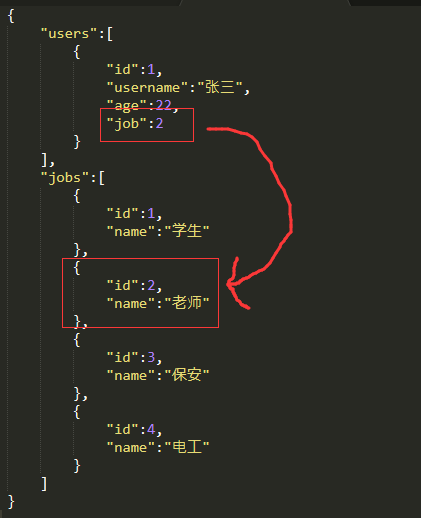
接下来需要查询两个数据接口,获取用户信息和职业,接下来开一个接口,详见文章json-server模拟服务器API .
再新增几条数据
{ "users":[ { "id":1, "username":"张三", "age":22, "job":2 }, { "id":2, "username":"李四", "age":18, "job":4 }, { "id":3, "username":"王五", "age":36, "job":3 } ], "jobs":[ { "id":1, "name":"学生" }, { "id":2, "name":"老师" }, { "id":3, "name":"保安" }, { "id":4, "name":"电工" } ] }
例如想获取id为2的用户信息,接口路径如下
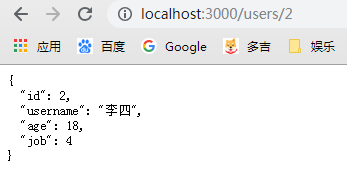
将之前封装的ajax方法调用过来,然后进行调用,如下所示

接下来刷新页面,做下测试
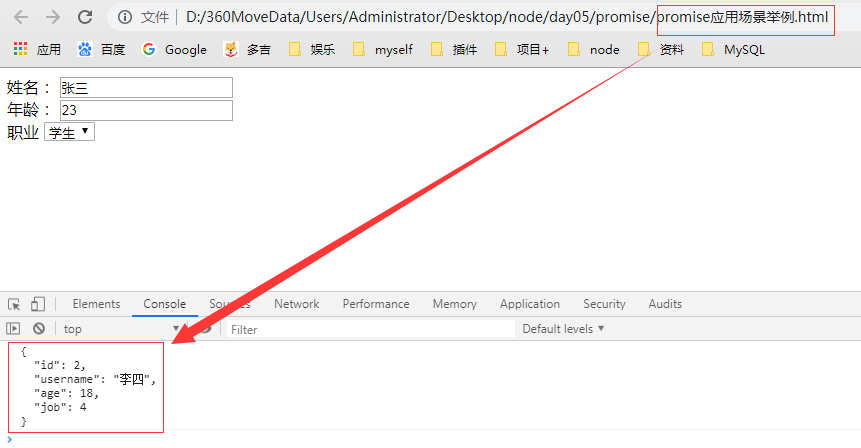
此时页面控制台根据接口输出id为2的学生信息,因为默认格式为字符串,需要进行解析成js对象


4、模板引擎
接下来需要将对象内容结合模板引擎art-template(前端客户端模板引擎)渲染到页面,首先下载到当前项目,然后引入


编写渲染模板,将form表单内容编写至模板里
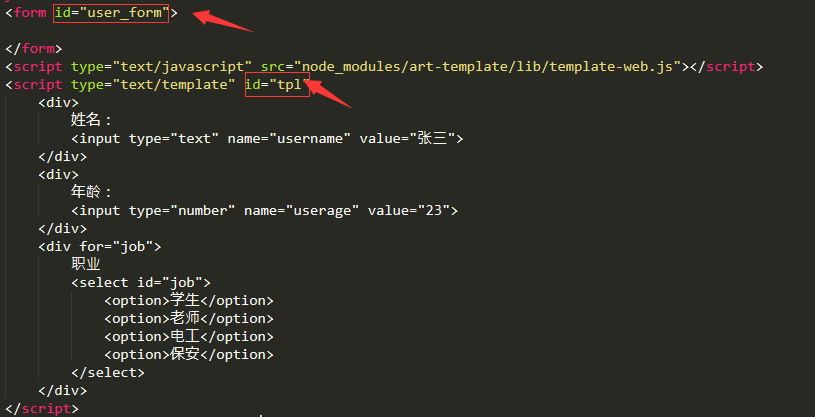
然后编写渲染语法

模板变量
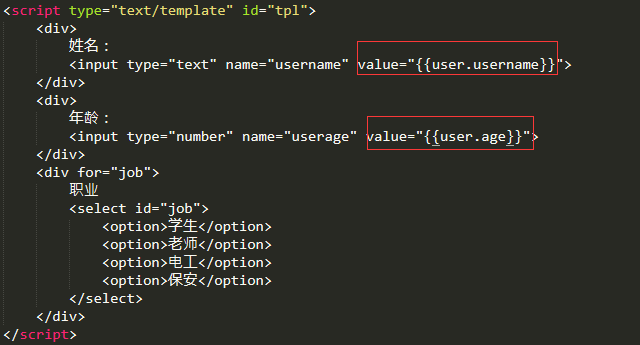
然后进行渲染

此时刷新页面,结果如下(id为2的员工信息)

(2)职业数据
接下来操作职业数据



然后需要判断当前人员职业,将该职业设为默认选中状态

此时便完成了接口调用渲染
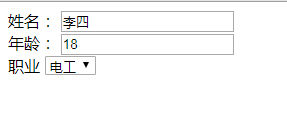
此时看到的数据,便是通过两个接口结合获取的。 假设需要用到3个、4个更多接口,代码嵌套太深,这是callbak方式的解决方式 接下来可以使用Promise方法解决 注意:【jQuery】的ajax已经支持promise的api方式
总结代码如下
<!DOCTYPE html>
<html>
<head>
<meta charset="utf-8">
<title>Promise应用场景举例--信息分类展示</title>
</head>
<body>
<form id="user_form">
</form>
<script type="text/javascript" src="node_modules/art-template/lib/template-web.js"></script>
<script type="text/template" id="tpl">
<div>
姓名:
<input type="text" name="username" value="{{user.username}}">
</div>
<div>
年龄:
<input type="number" name="userage" value="{{user.age}}">
</div>
<div for="job">
职业
<select>
{{each jobs}}
{{if $value.id === user.job}}
<option id="{{$value.id}}" selected>{{$value.name}}</option>
{{else}}
<option id="{{$value.id}}">{{$value.name}}</option>
{{/if}}
{{/each}}
</select>
</div>
</script>
<script type="text/javascript">
get('http://localhost:3000/users/2',function(usersData){
get('http://localhost:3000/jobs',function(jobsData){
var htmlStr = template('tpl',{
user:JSON.parse(usersData),
jobs:JSON.parse(jobsData)
})
document.querySelector('#user_form').innerHTML = htmlStr
})
})
/*自定义封装ajax*/
function get(url,callback){
var xhr;
if (window.XMLHttpRequest) {
xhr = new XMLHttpRequest()
} else {
xhr = new ActiveXObject("Microsoft.XMLHTTP")
}
xhr.open('get',url, true)
xhr.send()
xhr.onreadystatechange = function() {
if (xhr.readyState == 4 && xhr.status == 200) {
var responseText = xhr.responseText
callback(responseText)
}
}
}
</script>
</body>
</html>
(3)jQuery的ajax调用Promise的API
1、首先下载引入jquery


2、对比
之前使用jquery的ajax都是callback方式

接下来使用promise方式

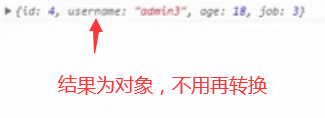
接着调用
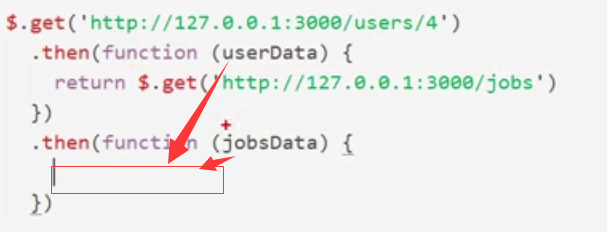
这里注意第二个then获取的是第一个的return返回值,无法获取第一个then的data数据,所以这需要新建对象

接下来编写模板即可
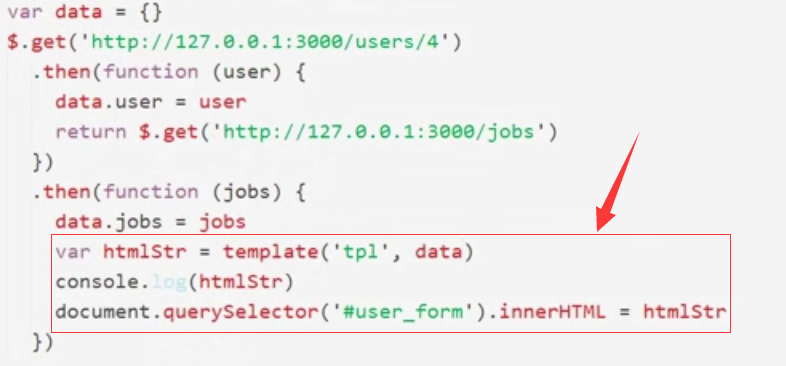
3、完整代码如下
<!DOCTYPE html>
<html>
<head>
<meta charset="utf-8">
<title>Promise应用场景举例--信息分类展示</title>
</head>
<body>
<form id="user_form">
</form>
<script type="text/javascript" src="node_modules/art-template/lib/template-web.js"></script>
<script type="text/template" id="tpl">
<div>
姓名:
<input type="text" name="username" value="{{user.username}}">
</div>
<div>
年龄:
<input type="number" name="userage" value="{{user.age}}">
</div>
<div for="job">
职业
<select>
{{each jobs}}
{{if $value.id === user.job}}
<option id="{{$value.id}}" selected>{{$value.name}}</option>
{{else}}
<option id="{{$value.id}}">{{$value.name}}</option>
{{/if}}
{{/each}}
</select>
</div>
</script>
<script type="text/javascript" src="node_modules/jquery/dist/jquery.js"></script>
<script type="text/javascript">
var dataInfo = {}
$.get('http://localhost:3000/users/2')
.then(function(user){
dataInfo.user = user
return $.get('http://localhost:3000/jobs')
})
.then(function(jobs){
dataInfo.jobs = jobs
var htmlStr = template('tpl',dataInfo)
document.querySelector('#user_form').innerHTML = htmlStr
})
/*
旧版回调语法
get('http://localhost:3000/users/2',function(usersData){
get('http://localhost:3000/jobs',function(jobsData){
var htmlStr = template('tpl',{
user:JSON.parse(usersData),
jobs:JSON.parse(jobsData)
})
document.querySelector('#user_form').innerHTML = htmlStr
})
})
*/
/*自定义封装ajax
function get(url,callback){
var xhr;
if (window.XMLHttpRequest) {
xhr = new XMLHttpRequest()
} else {
xhr = new ActiveXObject("Microsoft.XMLHTTP")
}
xhr.open('get',url, true)
xhr.send()
xhr.onreadystatechange = function() {
if (xhr.readyState == 4 && xhr.status == 200) {
var responseText = xhr.responseText
callback(responseText)
}
}
}
*/
</script>
</body>
</html>
此时便成了链式调用
.